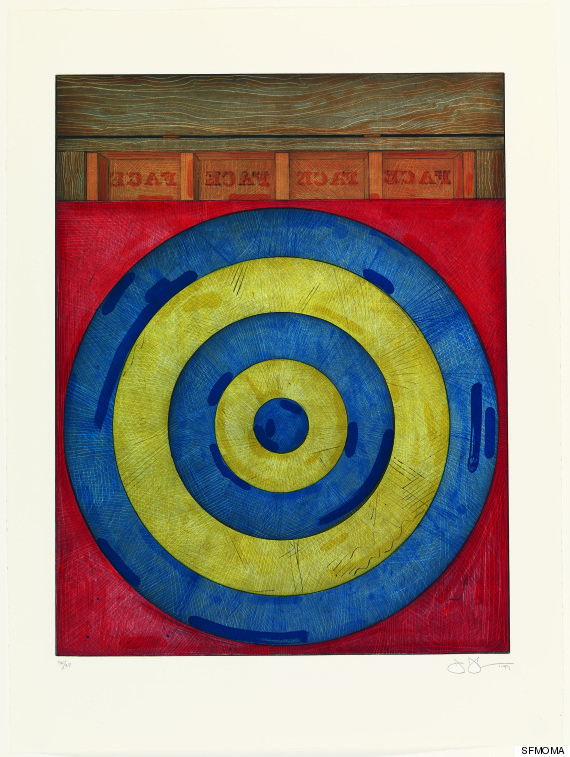Tuesday, November 20, 2012
Jasper Johns: Seeing with the Mind's Eye
Jasper Johns, 0 through 9, 1960; oil on canvas; 72 x 54 in. (182.8 x 137.1 cm); Collection of Helen and Charles Schwab, fractional gift to the San Francisco Museum of Modern Art; © Jasper Johns / Licensed by VAGA, New York, NY
Throughout his career, contemporary American artist Jasper Johns, now 82, has found new ways to explore, as he once put it, "how we see and why we see the way we do." Continually reinventing his own work, he has driven key transformation in the art world for nearly 60 years. On view at the San Francisco Museum of Modern Art (SFMOMA) from November 3, 2012, through February 3, 2013, Jasper Johns: Seeing with the Mind's Eye surveys the full scope of Johns's achievements and also reflects the very particular interest in his art in the San Francisco Bay Area.
This major exhibition, the first museum overview in San Francisco in 35 years, was organized in close cooperation between Jasper Johns and Gary Garrels, SFMOMA's Elise S. Haas Senior Curator of Painting and Sculpture, who has been a longtime advocate of Johns in the Bay Area. Ranging across Johns's entire career—from his breakthrough paintings of the 1950s, which paved the way for the subsequent development of Pop art and Minimalism, to his most recent work—the survey offers a rich overview of the visual and philosophical inquiries central to Johns's practice and illuminates his enormous impact on artistic developments following Abstract Expressionism.
Target with Four Faces, 1979; color etching, soft-ground etching, and aquatint.
The presentation also celebrates the significant holdings of Johns's work in the region, bringing together for the first time some 90 paintings, sculptures, drawings, and prints from SFMOMA and other local and private collections as well as several key works lent by the artist himself, including a large recent canvas that will be on view to the public for the first time.
"In reviewing Johns's career, what becomes evident at every stage is the endless curiosity and discipline of the artist, and the astonishing level of ambition and quality of the work," says Garrels. "His art and thinking continually inspire other artists, as well as some of the field's most incisive critical writing. Johns has always been a prime instigator of change, and it makes sense that his art would strike a chord with collectors and museums over the past few decades in the Bay Area with its legacy of innovation."
Six Decades of Restless Invention
Jasper Johns was born in Augusta, Georgia, in 1930 and currently lives and works in New York City. He studied art at the University of South Carolina, but soon moved to New York where he met Robert Rauschenberg, John Cage, and Merce Cunningham, becoming a central force in the intensive reconsideration of contemporary arts unfolding at the time. In the 1950s, he developed a distinctive painting style that would help lead American art away from the then dominant movement of Abstract Expressionism. Unlike that energetic style, Johns's work was seemingly mute and serene, at once taciturn and vibrant, quixotic and matter-of-fact. Apart from occasional found objects or cryptic references to his own life, he painted mostly impersonal motifs early in his career, such as numbers, maps, and flags. The exact correspondence of figure and ground in his work also challenged the traditional distinction between an object and its depiction.
Jasper Johns: Seeing with the Mind's Eye has been installed roughly chronologically, beginning with a selection of Johns's first mature paintings, drawings, sculptures, and prints from the 1950s and 60s, focusing on one of his most iconic early subjects: numbers. For the artist, these were things "seen and not looked at, not examined" and therefore perfect vehicles for understanding the familiar in a new way. The exhibition then moves through canvases with dramatic brushstrokes and high-keyed colors that obscure clearly identifiable subjects.
The presentation continues with key examples from Johns's early sculptural and lead relief works based on common objects
(Light Bulb II, 1958), for which he used Sculp-metal, a silver-gray material that echoes his gray paintings of the same time
(Canvas, 1956). It also looks at Johns's play with language and his elaborate Duchamp-inspired puns between word and image
(The Critic Sees
Wall Piece, 1968; Bread, 1969; The Critic Smiles, 1969); and explores the way Johns begins introducing more psychological, personal references to his canvases
(Land's End; 1963;
Periscope [Hart Crane], 1963; Souvenir 1964).
In the 1970s, Johns initiated his Crosshatch series (Corpse and Mirror, 1978; Between the Clock and the Bed, 1981), abstract compositions of colored brushwork that recall his earlier work, but now individual strokes are distinct and gathered in parallel groupings arranged at angles. From this point on, Johns's work increasingly includes autobiographical references such as the artist's shadow, first seen in his Seasons series (Summer and Fall, 1987).
Johns began a new mode of investigation in the 1990s that would become known as his Catenary works (Bridge, 1997)—spare, muted gray canvases marked by a string that hangs across the field of the painting. Over the past ten years, Johns has also started a new series of works on paper and plastic that he calls Shrinky Dinks after the children's craft material utilized in their creation. And most recently he has developed a series of works based on a totemic black figure, represented in( Bushbaby 2005), a monumental painting that will be on view for the first time with this exhibition.
A Contemporary Master's History with SFMOMA and the Bay Area
Johns first visited San Francisco in the spring of 1964 to attend performances of works by his friend the composer John Cage. Two major paintings of that year—Souvenir and Souvenir 2—are rooted in an experience Johns had at the concerts; Souvenir has been on long-term loan from the artist to the museum since it was included in an exhibition at SFMOMA in the late 1990s.
The key early event for SFMOMA's relationship to Johns was the gift to the museum from Harry W. and Mary Margaret Anderson in 1972 of one of the artist's most celebrated paintings, Land's End (1963), which remains a cornerstone of the museum's postwar collection. The Andersons have also been collecting Johns's prints for many years.
In 1978, SFMOMA was the only other American museum to host the large midcareer survey exhibition of Johns's work organized by the Whitney Museum of American Art in New York. At the close of the exhibition in San Francisco, Johns placed another key work, the monumental Wall Piece (1968), on extended loan to SFMOMA where it has remained ever since.
In 1991, in anticipation of SFMOMA's new Mario Botta–designed building, Johns made a gift to the museum of a lead Splash sculpture by Richard Serra, originally commissioned by Johns in 1968 for a building he owned in New York.
More recently, in 1999, SFMOMA organized Jasper Johns: New Paintings and Works on Paper, which marked the first public presentation from the artist's Catenary series and traveled nationally. Charles and Helen Schwab purchased the first painting in the series, Bridge (1997), as a promised gift to SFMOMA along with the related drawing. Following the close of that exhibition, Johns subsequently placed his much-storied gray painting Canvas (1956) on long-term loan to SFMOMA. Other private collectors and collections with deep and multifaceted ties to SFMOMA and Johns's work in particular include The Doris and Donald Fisher Collection at SFMOMA and Carolyn and Preston Butcher.
In addition to the presentations at SFMOMA, many exhibitions in the region have included or focused solely on Johns's work over the last forty years, including his first solo show in the Bay Area, Jasper Johns: Prints at the John Berggruen Gallery (1970), and exhibitions of his graphic works at the University Art Gallery, California State University, San Jose (1973), the University Art Museum, University of California, Berkeley (1978), the San Jose Museum of Art (1979), and the Oakland Museum (1979). Jasper Johns: Printed Symbols, a major traveling exhibition, was hosted by the Legion of Honor (1990); and a solo exhibition of the artist's works on paper inaugurated the de Young Museum's Anderson Gallery of Graphic Art (2005).
CATALOGUE OFFERS FOCUSED LOOK AT SPECIFIC WORKS
A catalogue published by SFMOMA on the occasion of the exhibition features new thematic texts by veteran and recent Johns scholars alike. Essays range from historical to critical to poetic, and take an in-depth look at specific works of art and series from all periods of Johns's career. Authors include exhibition curator Gary Garrels; Roberta Bernstein, author and director of the Catalogue Raisonné of the Paintings and Sculpture of Jasper Johns; Brian M. Reed, professor of English at the University of Washington; James Rondeau, chair and Frances and Thomas Dittmer Curator of the Department of Contemporary Art at The Art Institute of Chicago; Mark Rosenthal, author of Jasper Johns: Work Since 1974; Nan Rosenthal, author of The Drawings of Jasper Johns; Richard Shiff, Effie Marie Cain Regents Chair in Art at The University of Texas, Austin; and John Yau, author of A Thing Among Things: The Art of Jasper Johns. The book also features a new chronology that enumerates Johns's many exhibitions in the Bay Area.
Jasper Johns: Seeing with the Mind's Eye is organized by the San Francisco Museum of Modern Art. Presenting support is provided by the Mimi and Peter Haas Fund and the Evelyn D. Haas Exhibition Fund. Premier corporate support is generously provided by Bank of America. Major support is provided by Martha and Bruce Atwater and The James C. Hormel and Michael P. Nguyen Endowment Fund. Generous support is provided by Dr. Nancy Ascher and Dr. John Roberts, Christopher Bass, Gay-Lynn and Robert Blanding, Jean and James E. Douglas Jr., Patricia W. Fitzpatrick, Marissa Mayer and Zachary Bogue, Ann and Robert S. Fisher, and Thomas W. Weisel and Janet Barnes. The exhibition is supported by an indemnity from the Federal Council on the Arts and the Humanities.







